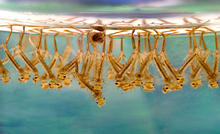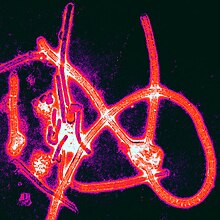Wikimedian in Residence on Open Science: an interview with Daniel Mietchen





Daniel Mietchen, a biophysicist, a contributor on the Wikimedia projects including the Wikimedia Research Committee, and the managing editor of Citizendium, has been awarded a grant by the Open Society Foundations to be the Wikimedian in Residence on Open Science. The Wikimedia blog has an announcement and so does Daniel on the new blog set up for the project by its institutional host: the Open Knowledge Foundation Germany.
The project's stated goal is "improving Open Access coverage and reuse in WMF projects". Images are already being reused from many Open Access scientific journals, but such reuse could be extended across many more Wikipedia languages and also into sister projects like Wikibooks, Wikispecies, Wikisource, Wikiquote and Wikiversity. Mietchen's role marks an interesting development for the Wikimedians in Residence programs which have thus far been primarily involved in cultural sector outreach as part of GLAM collaborations. The post on the Wikimedia blog has a number of ways Wikimedians can get involved in this initiative.
The Signpost caught up with Mietchen to talk about what the project entails.
Could you tell us a bit more about yourself?
- I trained as a biophysicist and have spent the last decade applying Magnetic Resonance Imaging and related techniques to the study of biological systems ranging from single cells to embryos to brains and fossils. This provided me with multiple perspectives on collaboration and sparked an interest in the integration of scientific workflows with the web, an area in which I am now freelancing. I signed the Budapest Open Access Initiative soon after it had been released to the public in early 2002, around the time when I started using the Wikipedias as a language learning tool and made my first drive-by edits. Since then, my interest in doing science in the open has continued to grow, and tools like blogs and wikis are a natural helper with that. The focus of my edits here as well as on Wikiversity, Citizendium and other wikis is on scientific topics, and my activities on Meta concentrate on RCom.
Wikipedians and Signpost readers will be aware of the Wikimedian in Residence projects done by GLAM institutions like the British Museum and National Archives and Records Administration, but what exactly does this initiative do that's different?
- I would rather emphasize the similarities – especially the partnering of Wikimedia and expert communities – and that the worlds of GLAM and scientific research are heavily intertwined, which shall be reflected in the new project being integrated with WP:GLAM. But there are indeed a number of differences:
- Coverage of the target topic: The GLAM initiatives build on articles around the GLAM theme already having quite a bit of content, and on the related WikiProjects (e.g. Museums) being active, so that it makes sense to focus on highlighting and improving articles related to individual institutions and their exhibits. Topics related to Open Science – and even its flagship Open Access – are much less popular with both readers and editors, so even the overarching WikiProject Science is not very active, and coverage of subtopics like Open Access remains very patchy. For instance, there is an article about the journal Atmospheric Chemistry and Physics but not about its publisher, Copernicus Publications, who would be the partner in a GLAM-like scheme. In this sense, the current project lays the ground for future activities involving collaboration with individual stakeholders of the kind that characterizes the GLAM projects already today, and the "residence" part is mainly online, with meetups at Open Access and Wikimedia events.
- Reuse of content from partners: GLAM institutions do not generally put their web content under licenses that would allow reuse on WMF projects. This is at the heart of the controversy with the UK's National Portrait Gallery, and image donations are a common workaround. However, many open access publishers already use WMF-compatible licenses (mostly CC-BY), so their output could be considered a perpetual flow of donations which, moreover, yields itself more easily to automation than one-time donations. Facilitating the re-use of open access resources is thus another focus of this project, and it extends beyond Wikipedia to all WMF projects.
- Policy: There is no WMF policy on GLAM (and no need for it), but RCom is working on an open access policy for WMF-related research projects, and having a closer interaction between the WMF and OA communities will certainly help in making this policy useful.
Do you think there are any potential areas of conflict that might arise between the role of peer-reviewed scientific journals which are pushing the leading edge of science, and Wikipedia which is trying to conservatively record the status quo of what is verifiable?
- I don't think this black-and-white image of progressive and conservative elements holds but yes, there certainly is potential for conflict, since the two processes work quite differently and serve quite different purposes. There are benefits as well: it is hard to verify anything hidden behind access walls, so making peer-reviewed content accessible for free is a first step towards both Open Science and WP:V. The logical next steps towards Open Science are to make not just the final paper available but also all the data and code supporting claims made in the paper. The Open Knowledge Foundation and others are working in this direction. Besides, I think that the scientific peer review process (not just for journals, but equally for grant proposals) would benefit from being more open, e.g. by publishing all peer reviews along with the papers in a way similar to talk page comments accompanying a wiki page. Some publishers (e.g. BioMed Central) already go that route, and such reviews can then again help editors with relevant expertise to make sense of the paper and to evaluate what it means for the status quo of related Wikipedia articles.
- Plus, more and more scholarly journals – and not just the OA ones – allow comments on the articles they publish. The feature is not widely used by the scholarly community, but can certainly be regarded as an invitation to the broader public to engage with the research reported there. So if there is a problem with a particular open access article, or if a WMF project reuses some materials thereof, then there is nothing wrong with leaving a note there (example).
Will having a Wikimedian in Residence working specifically on Open Science help with bridging the gap between experts and the editor community on Wikipedia?
- The coverage and policy parts of the project won't help much beyond raising awareness for these issues, but the re-use part has some potential to indirectly facilitate such bridging by virtue of Wikipedia's high search engine rankings, which will likely increase expert exposure to Wikipedia content derived from Open Science or Open Access sources. Whether that translates into increasing expert participation or retention is beyond the scope of the project, but one could envisage ways in which the interactions between the wiki and OA communities in the framework of this project could serve as a test case for expert engagement and retention.
For more information, you can visit the Wikimedian in Residence blog, read the welcome post on the Open Knowledge Foundation Germany site or check out the project's home on Meta.


Discuss this story
A comment concerning the coverage of open access journals on Wikipedia. WikiProject Science deals with capital-S Science. As such it would be much more interested in articles on say Occam's Razor, Falsifiability, or articles about "Science as endeavour", making its scope a bit closer to what you would expect from a project named "WikiProject Natural Philosophy" instead. Anything that is closer to "actually doing science" will be taken care of by a more focused WikiProject such as WikiProject Physics, WikiProject Chemistry, WikiProject Biology, WikiProject Neurology, and so on.
In the case of scientific publications, the most relevant project (and it is quite an active one) is WikiProject Academic Journals. We do not particulary focus on open-access journals, mostly because open-access journals tend to be newer and most of them did not have time to become impactful, or became drowned in the sea of open-access online journals that flourished because of the greater ease and cheaper cost of online publishing compared to traditional print journals. What we do is focus on the impactful journals, especially those heavily-cited by Wikipedia, as we consider them to be those of greater relevance to Wikipedians readers.
There are similar efforts to improve the coverage of publishers, but journals have enjoyed the spotlight given by our compilation of journals cited by Wikipedia of WikiProject Journals for a few years now, while publishers have neither a compilation, nor a WikiProject dedicated to them. Headbomb {talk / contribs / physics / books} 23:03, 25 July 2011 (UTC)[reply]
|arxiv=parameter of citation templates, such as{{cite journal|arxiv=1234.5678}}, which would probably be in the few thousands. Likewise, by looking for journals from SAGE Publications by DOI, you will also miss citations to SAGE journals where the DOIs was not specified (or to books published by SAGE, if they publish books). The PNAS count should probably be closer to 20,000 if you compile all its possible spellings and abbreviations. Headbomb {talk / contribs / physics / books} 07:30, 26 July 2011 (UTC)[reply]{{cite journal|arxiv=...}}is a bit harder to gauge, but it's used at least once in around 2460 articles. So usage is closed to 6,000 give or take a few hundred cases. Headbomb {talk / contribs / physics / books} 15:50, 27 July 2011 (UTC)[reply]